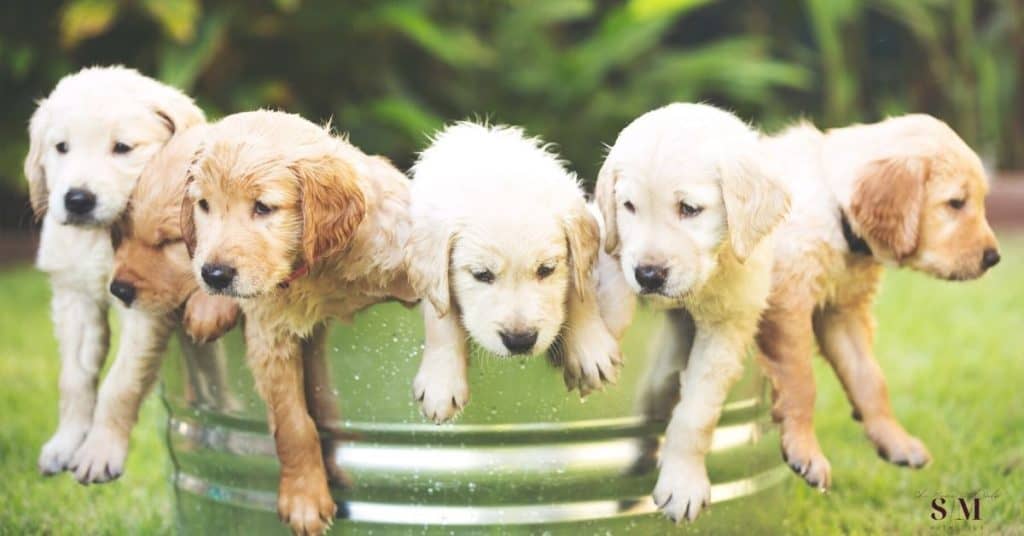HOW DO I KNOW IF MY PUPPY HAS FLEAS?
HOW DO I KNOW IF MY PUPPY HAS FLEAS?
Generally speaking, there are a few steps you can perform to check if your puppy has fleas:
- check your dog’s behaviour for obvious signs, such as excessive scratching;
- inspect your puppy’s coat, in order to spot fleas on its skin;
- look for fleas or flea dirt (flea faeces) in your home environment.
Read this post for easy steps to follow in order to know if your puppy has fleas and to get rid of them safely, effectively and fast.

The following post may contain affiliate links, which means I’ll get a small commission if you decide to buy using the links provided. This will add NO EXTRA COST to you but it helps me to keep this blog up and running. Thank you. You can get more info by reading my Disclaimer page.
Fleas are a very common external parasite, and pet owners know the struggle of keeping them away, especially during the warmer months of spring and summer.
Not only fleas are gross, but they can present health challenges to your pet, to you and your family if left untreated.
Therefore, it is very important that you know how to recognise if your puppy has a flea infestation, so that you can start treating it straight away, to prevent more serious diseases.
WHAT ARE FLEAS?
According to www.britannica.com “flea, (order Siphonaptera), any of a group of bloodsucking insects that are important carriers of disease and can be serious pests. Fleas are parasites that live on the exterior of the host (i.e., are ectoparasitic). As the chief agent transmitting the Black Death (bubonic plague) in the Middle Ages, they were an essential link in the chain of events that resulted in the death of a quarter of the population of Europe. […] Fleas are small, wingless insects with a tough cuticle bearing many bristles and frequently combs (ctenidia) of broad, flattened spines. The adult flea varies from about 0.1 to 0.32 cm (0.039 to 0.13 inch) in length and feeds exclusively on the blood of mammals (including humans) and birds.
WHAT IS THE FLEA LIFE CYCLE?
I found the answer to this question on the CDC website: “Most fleas have four life stages: egg, larva, pupa (in a cocoon), and adult. […] The lifecycle of fleas can be very quick or last many months to years depending on the environmental conditions throughout the life stages.”.
This is how the CDC (the centre for disease control of the United States) website describes the life of a flea:
- After finding an animal or human host and taking a blood meal, adult fleas will mate and begin laying eggs in the fur and surroundings of the host. Eggs will hatch in one to ten days depending on environmental conditions such as temperature and humidity.
- After hatching from an egg, fleas enter their larval stage. Larvae are free moving and feed on blood and flea faeces (poop; also called “flea dirt”), in order to continue their development.
- Within 5-20 days of feeding on flea dirt, the larvae will spin a cocoon, and enter the pupa stage. The cocoon protects pupa from environmental conditions and insecticides/repellents for several days or weeks until adult fleas are ready to emerge.
- Adult fleas will not emerge from the cocoon until there is a clear presence of a host, such as movement or body heat, which will signal that there is a blood meal readily available.
- Adult females begin to feed from a host within a few hours of emerging from the cocoon and soon after will mate and begin laying eggs.
HOW DO DOGS GET FLEAS?
Unfortunately, it is very easy for dogs to get in contact with fleas.
Fleas are wingless insects, so they can’t fly from one animal to another. However, they can jump up to 13 inches, and that is precisely how they can spread from pet to pet.
Your dog can get in contact with fleas at daycare, at local dog parks, in a dog kennel, or simply when out and about.
Fleas can easily hide in tall grass for prolonged periods of time without a host animal, and can wait till a pet comes around to jump on it. That is to say that your puppy can get infested even if it doesn’t get near another dog.
HOW DO I KNOW IF MY PUPPY HAS FLEAS?
There are several ways you can check your puppy for evident signs of a flea infestation.
Let’s go through them.
CHECK YOUR DOG’S BEHAVIOUR
A change in your dog’s behaviour is probably the very first clue to a flea infestation.
Indeed, a puppy that has fleas will display a particular set of behaviours.
Flea bites are very itchy, so your dog will most likely scratch obsessively and chew its skin frequently.
In addition to that, look for other evident signs of flea infestation such as:
- over tiredness;
- loss of appetite;
- a general feeling of uneasiness;
- head shaking;
- hair loss.
All of the above are common early signs of flea INFESTATIONs. However, your puppy might display all of them or none at all. Always talk to your Vet if you are in any way concerned about your dog’s health. Do not wait!
important
Always wear protective gloves when touching and checking your pet’s coat.
Do not inspect your dog or handle any tool for that purpose without protecting your hands first! Fleas can bite humans too, and in some cases they can cause severe allergic reactions and serious health issues!
inspect your puppy’s coat

If, after observing your puppy’s behaviour, you suspect a flea problem, your next step should be to check its coat.
Move your fingers across your dog’s fur in order to part it slightly and examine the skin.
In general, first signs of a flea infestation in dogs can be spotted when examining the base of their tail and behind the ears.
At a closer look, you should be able to spot tiny red bumps on your dog’s skin, which are flea bites. Although these red dots are generally very small, some dogs might develop a serious reaction to flea’s saliva, that can produce a large, irritated and red area on the skin.
In addition to flea bites, you should also be able to spot adult fleas.
Indeed, adult fleas are large enough to be seen with a naked eye, and without a special instrument. However, if you want to be 100% sure, a good idea would be to use a flea comb.
WHAT IS A FLEA COMB?
A flea comb is a handy tool to have if you are a dog owner. They work similarly to a lice comb for humans.
This type of pet’s comb is not treated with any chemical, making it an ideal tool to kill fleas naturally.
Simply brush your dog’s coat daily with this comb to:
- check for a flea infestation;
- prevent infestations;
- get rid of fleas (it is ideal to brush your pet first and then treat it with another natural remedy to increase your chances of success).
You could get a flea comb at your local pet store, or online.
HOW DO YOU USE A FLEA COMB?
Using a flea comb is as simple as brushing your dog with it daily.
A little trick you could use in order to confirm a flea infestation, is to place a white towel or sheet on the floor, and let your puppy stand on it while brushing him.
As you brush, you might see fleas falling onto the towel, therefore confirming your suspicions.
In order to use a flea comb effectively, please follow these simple steps:
- fill a small bowl with hot soapy water;
- applying a slight pressure, place the flea comb on your dog’s coat and start brushing it. Make sure the comb stays in contact directly with the skin throughout the brushing;
- after each brushing, examine the comb for fleas and flea dirt;
- rinse the comb in the hot soapy water;
- brush another section of your puppy’s coat;
- repeat all steps till you have brushed and checked the entire coat;
- clean and disinfect your flea comb for the next use;
- dispose of the dirty soapy water immediately and clean and disinfect the bowl for the next use.
WHAT IS FLEA DIRT?
Flea dirt, also known as adult flea feces, is the waste left behind by fleas. These black droppings serve as food for the juvenile fleas, just hatched from their eggs, so it is vital you know how to recognise them if you want to get rid of a flea infestation.
It presents as brownish or black dirt, easily mistaken for regular dirt from the soil.
A way to check if your dog has flea dirt, is to run it under water. Flea dirt will turn red when exposed to water.
inspect your puppy’s MOUTH
Another way to know if your puppy has fleas, is to check its mouth.
When a dog has a flea infestation, it can develop pale gums, as a result of blood loss due to flea bites.
Although this might only happen in severe cases of flea infestations, anemia from flea bites is very dangerous, especially in puppies and small dogs.
It is very important you contact your vet’s office immediately if you suspect your pet has anemia. Early treatment is vital to avoid serious issues.
look for fleas or flea dirt (flea faeces) in your home environment.
After inspecting your pet, it’s time to check your home.
This might seem as a superfluous step, but trust me when I say it is not.
If your pet indeed has a flea infestation, you will need to treat your entire home in order to get rid of it, and to prevent possible health risks to you and your family.
Start by examining your pet bedding and all the areas where it spends most of the time. You might be able to spot adult fleas and flea dirt on hard floors, as well as on carpets and soft furniture (like sofas).
Walking around your home wearing white socks over your trousers, could help you in spotting fleas. If adult fleas are indeed present on floors or carpets, most likely they will jump on your feet and ankles and attach to the socks.
HOW TO GET RID of fleas on a puppy fast
There are many products you could buy at your local pet store in order to get rid of a flea infestation on your puppy. To name a few, you could purchase topical liquids such as special flea shampoos, a flea collar or a spray.
However, I do not recommend using any of those chemical loaded products, as they might be toxic to you and your pet. You might want to be extremely careful especially if your dog is very young.
My first methods of choice are natural remedies. I like to use natural ingredients whenever possible, as I find they are just as effective treatments, without the health risks.
If you want to know how to get rid of fleas on a puppy fast using natural remedies, please check this post: “HOW TO KILL FLEAS AND TICKS NATURALLY”.
IMPORTANT
Always follow the advice of your trusted vet before using any product on your pets.
While essential oils and natural ingredients are generally safe for dogs, some animals might be sensitive to some ingredients, or might develop an allergic reaction. Immediately stop any treatment if you notice any reaction, such as a skin irritation on your dog. Seek immediate help from your local vet if you are concerned about your pet’s health at any stage.
The same advice applies to you and the rest of your family. Although the natural ingredients used in the recipes below are generally safe, always consult with your doctor before using any product. Pay particular attention if you suffer from any condition, allergy or if you are pregnant or breastfeeding.
Seek immediate advice and help from your trusted medical care provider if you are concerned about your health or that of your family.
HOW TO GET RID OF FLEAS IN YOUR HOME FAST, USING NATURAL INGREDIENTS!
As mentioned above, if your puppy has fleas, you will need to treat your home too.
This is a necessary step that, unfortunately, can’t be avoided.
It is pointless to treat your pet only to have it walk back into an infested environment.
Not to mention the fact that fleas can present a danger to humans as well.
Naturally, I know how overwhelming the thought of disinfecting your home might be. This is why I wrote an entire post to help you. Here I cover the entire process, with simple step- by – step instructions. They are very easy to follow, and will make your efforts well worth. Your home environment will be clean and pest-free in no time!
How to prevent A FLEA INFESTATION
Last but not least, you might want to know how to prevent future flea infestations.
There are several natural ways you could use to protect your beloved puppy.
You could for example make an all natural flea spray or flea collars.
I explain what are the best essential oils bug repellent recipes in this post here, so you could decide which one works best for you, your family and your pets.
IMPORTANT
When using Essential Oils, make sure to use only CPTG Certified, Pure, Tested Grade ones, like Doterra Essential Oils. The content of this blog post and any information provided here has not been evaluated by any government entity or medical practitioner. It is NOT intended to diagnose, treat, cure or prevent any disease, illness or condition. It is NOT intended to be a substitute for medical counselling. If you are pregnant, breastfeeding, or suffering from any medical condition or illness or injury, you SHOULD consult a qualified healthcare professional before using any product.
HOW TO GET RID of fleas on a puppy fast: conclusions
Dealing with a flea infestation may be a very distressing experience for you and your puppy.
It is important to make sure you know the telltale signs, so that you and your vet can start early treatment ASAP.
I hope this post has been helpful to you.
Please feel free to leave a comment below, I’d love to hear from you.
Till next time, Dee.
IF YOU ARE DEALING WITH PESTS IN YOUR HOME AND WITH YOUR PETS, YOU MIGHT LIKE TO READ THE FOLLOWING POSTS:

The Best Essential Oils Bug Repellent Recipes
How To Kill Fleas And Ticks Naturally
How To Get Rid of Fleas In Your Home Fast Using Natural Ingredients
How To Kill Fleas With Diatomaceous Earth
How Do I Know If My Puppy Has Fleas?
Does Diatomaceous Earth Kill Bed Bugs?
The Best Essential Oils That Kill Bed Bugs
Hi, I’m Dee!
Mom of three; printables creator, natural solutions, simple living and homemade food enthusiast; “Outlander” fanatic.
When I’m not busy writing and designing, you can always find me covered in a cloud of flour in the kitchen, playing and crafting with my children, or making up some blends with my Essential Oils. Also I’m practically obsessed with Crystals and reading during my spare time.
Come along on our crazy journey as a family living in the countryside of Ireland!


